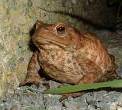Britain's toads at risk
Britain's toads at risk from deadly infection


Britain's toads are at risk from a deadly infection that has caused the extinction of many other amphibians. The chytrid fungus, or Batrachochytrium dendrobatidis (BD) was brought into the UK by imported frogs.
Infected toads are currently confined to Kent but, according to the Royal Society Journal report, the BD infection could wipe out the toad population if it spreads. One third of all losses of amphibian species are because of BD.
Toads infected with BD suffer from skin conditions. BD can infect the skin of frogs, toads, salamanders and newts.
Tighter controls of the aquarium trade, and the testing of all amphibians entering the country may help prevent such outbreaks, say experts.
Imperial College scientist Dr Matthew Fisher said: 'Under the worst case scenario, you could lose the common toad in the UK ? We strongly suspect BD is being introduced into the UK on a daily basis through the amphibian trade. Our borders are wide open to the introduction of this infectious disease.'
Wildlife charity Froglife said in a statement: 'It is thought that it could have been brought to the UK by exotic pet species, such as the African clawed toad, that have escaped or been deliberately released. It is vital strict controls on the health of imported animals are in place to help limit the spread of this devastating disease.'
Britain's toads are at risk of extinction from this deadly infection, chytrid fungus, or Batrachochytrium dendrobatidis (BD), but the frogs that are thought to have brought it in are now dead, and scientists are waiting to see if it has spread.
Exquisite houses, the beauty of Nature, and how to get the most from your life, straight to your inbox.
To comment on this article, use the comment box below, or email us at clonews@ipcmedia.com
Country Life is unlike any other magazine: the only glossy weekly on the newsstand and the only magazine that has been guest-edited by His Majesty The King not once, but twice. It is a celebration of modern rural life and all its diverse joys and pleasures — that was first published in Queen Victoria's Diamond Jubilee year. Our eclectic mixture of witty and informative content — from the most up-to-date property news and commentary and a coveted glimpse inside some of the UK's best houses and gardens, to gardening, the arts and interior design, written by experts in their field — still cannot be found in print or online, anywhere else.
